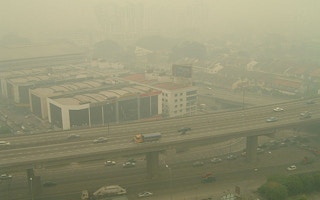The health ministries of Indonesia, Malaysia and Singapore have played down a study by Harvard and Columbia universities estimating a mean of more than 100,000 premature deaths resulting from the 2015 Southeast Asian haze crisis.
The study in Environmental Research Letters, a journal, derived a range of 26,300 to 174,300 premature deaths from measurements of fine PM2.5 particulate matter in air, which is proved to affect the brain, heart and lungs. The study compared the haze in 2015 with 2006, another year in which Indonesian wildfires sent palls of smoke over much of the region. Greenpeace characterised the study as “groundbreaking.”
“Now that we know the scale of the death toll, failure to act immediately to stem the loss of life would be a crime,” said Greenpeace Indonesia forestry campaigner Yuyun Indradi.
Statisticians have cautioned that the complexity of the scale and long timeframe of measuring PM2.5 makes a precise estimate difficult. However, Howard Frumpkin, dean of the School of Public Health at the University of Washington, told the Associated Press that health consequences in at-risk, poorer populations could be more severe, due to the pre-existing susceptibility to ill health.
The governments of the three countries most-affected by the toxic haze have commented sparingly on the study. The study estimates last year’s haze was responsible for 2,200 premature deaths in Singapore, higher than the number of deaths from road accidents in the city state in the last 10 years combined.
State media reported the Singaporean Ministry of Health saying the study did not price in measures the government had taken to boost access to treatment. “We note that the modelling study does not take into consideration the mitigating measures that were implemented by countries affected by the haze,” the ministry said.
“
Now that we know the scale of the death toll, failure to act immediately to stem the loss of life would be a crime.
Yuyun Indradi, forestry campaigner, Greenpeace Indonesia
Indonesia’s health ministry told Reuters the government’s record of 24 haze-related deaths, which includes firefighters, is based on the cause of death listed on a death certificate. Director general of disease control Mohamad Subuh said modelling of mortality was “irresponsible.” The Harvard and Columbia study estimates a mean of 91,600 premature deaths in Indonesia. The study has received little coverage in Indonesian media.
The Indonesian government did, however, emphasise last year that the haze had affected tens of millions. “As last year’s fires raged, the Indonesian government said that 43 million people were exposed to smoke across the country, and half a million suffered from smoke-related respiratory illness,” said Greenpeace’s Indradi.
Malaysia’s health ministry also cast doubt on the findings.
“Of course, we had increased number of conjunctivitis cases and respiratory tract infections but it’s mostly due to the fact that some haze contained sulphur dioxide and nitric oxide, which comes from the burning of fossil fuel,” deputy health director-general Datuk S. Jeyaindran said on Monday. “We had no deaths last year directly related to the haze.”
The study estimates that last year’s haze killed 6,500 Malaysians. But Jeyaindran said, “We didn’t find any increase in the number of acute respiratory ailments from the haze. This has been going on year on year and our data shows there is no increase.”
The researchers’ model accounts for deaths not just from acute smoke inhalation but also from increases in strokes, heart attacks and other illnesses that can be brought on by excessive exposure to PM2.5 particles, which are tiny enough to enter the lungs and bloodstream.
Study co-author Jonathan Buonocore suggested that the 100,300 figure was likely a conservative account of the health fallout from last year’s crisis, as it only applied to deaths that could occur within one year of exposure to the haze, and only accounted for adults. Neither did the researchers’ model account for non-fatal occurrences such as heart attacks or strokes from which victims survive.
“One of the useful things about this study is that it points to the public health impacts that these fires have thrown on the region,” Buonocore told Mongabay.
This story was published with permission from Mongabay.com










